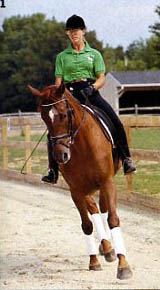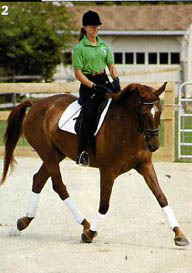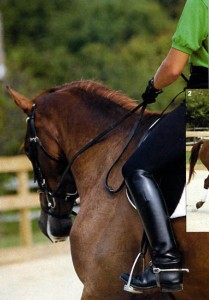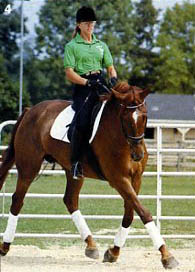What would you say if I told you the difference in strength your horse requires to do a 20-meter circle and to do a 10-meter circle is almost nil? He needs to step under a bit farther with his inside hind leg and bend his hocks a bit more, but a proper, comfortable, symmetrical 10-meter circle isn’t really a strength issue. It’s a balance issue, and in this article I’m going to help you lay that issue to rest with one simple, effective exercise: a 20-meter circle that spirals in to a 10-meter circle, then spirals back out again.

This low-key, no-sweat, straightforward exercise will not only help you teach your horse balance; it will allow you to test that balance. And when and if he “fails” the test by showing you that he’s lost his balance (I’ll tell you how to recognize the signs), it’ll be no big deal, because the exercise itself provides the cure. You’ll never have to back off until he’s stronger, more supple or more mature. You won’t have to wait until you’re more skilled or until a professional can help you. You won’t have to quit because you and your horse are getting flustered or angry. And six months or a year from now, when you and he are making 10-meter circles look like child’s play, this exercise will still be hard at work as a diagnostic part of your daily warm-up (Are you as balanced and supple as you were yesterday?) and a therapeutic part of your warm-down (Let’s work on that lack of right bend you showed me today).
When is your horse ready to start this exercise? When he can stay evenly bent through his whole body (rather than bent in his neck alone, an all-too-common fault at Training Level) on an accurate 20-meter circle at the walk, trot and canter. His rhythm will be consistent, he’ll be relaxed and his impulsion (or energy) will be strong.
Your horse should be able to maintain these qualities on his turn down the centerline (which is half a 10-meter circle), and neither fall, cut nor drift in or out on the turn?though I’d go ahead and start even if he’s not quite perfect yet and your centerline turns have judges making such comments as “not enough bend,” “bent to the outside” or “loss of balance.” He may only be able to spiral in to 19 meters for a while, but he’ll still improve his balance and his performance (and his test scores).
There’s another very good reason to start this exercise early, too: Not starting to work on a figure until you need it is not good training; you’ll end up rushing your horse so much that he’ll lose what you’re trying to help him learn. Start far in advance and you’ll have all the time you need.
What Spirals In, Spirals Out
Pick up a rising trot and establish a 20-meter circle with all the qualities we’ve been talking about: bending, energy, rhythm and relaxation. Use the circle to run a checklist on your basic aids as well. Are you bending your horse and maintaining his forward energy with your very constant, very consistent inside leg? If he backs off or gets too quiet, are you squeezing your inside leg a bit more until he moves forward again? Are you supporting him and keeping him from falling out of the arc of the circle by holding your outside leg back? Are you keeping your inside rein very light to encourage him to step energetically under himself with his inside hind leg? When he bulges or falls out, are you momentarily opening the rein to guide him back onto the circle? And once he’s there, are you lightening again? Are you keeping a consistent feel and creating your “diagonal aid” with your outside rein, receiving the rhythmic pushes from your inside leg, regulating his bend and drawing the size and shape of the circle? Good!

When you’re satisfied with the quality of the 20-meter circle and your aids, begin spiraling in. Stay sitting in the middle of your horse and bring your inside shoulder back an inch or two to align your shoulders with his shoulders; that slight adjustment will automatically bring your hop back and weight your inside seat bone. Guide him just inside the 20-meter circle by opening your inside rein, bringing your outside rein across his neck (but not crossing it over the withers) and pushing rhythmically with your outside leg.
Return to a very light feel on your inside rein and continue gradually spiraling in, using your outside rein and outside leg to steer and push your horse over. Take your time. The object is not to race to the center, but to keep the consistent feel and the same basic qualities you developed on the 20-meter circle. Every step of the way, think about the quality of the circle, not the size. Ask yourself, “Is my horse correctly, evenly bent with good energy in his gait? Is he rhythmic and relaxed? Is his circle a continuous curve?”

Whether you spiral in a little or a lot, your horse is going to reach a point?maybe at 18 meters, maybe at 11?where the answers to your questions are going to change from “yes” to “no.” He will have “lost it,” balance-wise. How can you tell? The first sign, if he’s a quiet horse, is loss of energy. He’ll slow down. If, on the other hand, he’s a bit hot, he’ll get tense and you’ll have lost relaxation. He may tell you he’s uncomfortable by coming above the bit. He may fall on his forehand and get quick and heavy in your hands. He may lose rhythm. His trot may get so irregular that he almost looks and feels lame. He may fall out. And if he suddenly gets hard to turn and you find yourself toppling to the outside and pulling on the inside rein, he’s saying, “I’ve had enough! I’ve gone as small as I can go!”
You could be creating at least some of the problem. Your horse may be falling out because he’s unbalanced or because you’re not supporting him enough with your outside leg. You may be spiraling in too acutely. You may be “motorcycling” by leaning to the inside, throwing him onto his inside shoulder and bringing your outside hand forward so your rein is loopy and ineffective. You may be turning him with your inside rein (he may have been successfully covering p for you during his half-10-meter circle turns onto the centerline, but he can’t compensate long enough to stay balanced through the second half of the circle as well). You may be slowing him down (slower does seem to make smaller easier) and thereby sacrificing rhythm and energy?in which case you’re not only not helping him master the exercise; you’re negating the whole point.
Regardless of what or who has caused or allowed your horse to lose his balance on a circle that is too small (even if it’s a 19-meter circle), he cannot rebalance and you cannot improve things by staying on that circle. So keep trotting, spiral back out to a bigger circle, refresh the gait, reestablish all the qualities that mean “balance”?and when you and he are comfortable once again, spiral back in. Soon enough he’ll be able to stay well balanced through the exercise at the rising trot. When that day comes, gradually introduce sitting trot, a few strides at a time. (If you’re quite secure in your seat, you and he may actually find the exercise more do-able at the sitting trot, which allows your inside leg to push and create energy more effectively.)
You can canter this exercise as soon as you can trot it?but with everything accelerated at the canter, you’ll find it doubly important to pay attention to keeping your horse’s bend, balance, relaxation and energy just right. Otherwise, you’ll be asking too much of him. Start slowly, allow plenty of time for his canter spirals to develop and expect that he could be spiraling perfectly at the trot for months before he is spiraling well at the canter.
On To the Circle
Once your horse is comfortable spiraling at the trot from 20 to 10 meters and back to 20 again, he’s ready to graduate to 10-meter circles. Do them first in the corners, where he’ll have walls to support him and help him maintain his balance: Trot down the long side. As you approach the corner, make sure your inside leg is bending him slightly to the inside and your inside rein is guiding his head in a little bit so that you can just see the corner of his inside eye. Squeeze with your inside leg to maintain his energy and half-halt on the outside rein to tell him, “Pay attention! Something different is coming.” Turn your upper body (remembering to sit in the middle of him) and with your outside rein and outside leg, push him onto the first half of the 10-meter cirlce, just as you would if you were starting your spiral or turning down the centerline.

This time, however, continue on around the second half of the circle and back to the corner. If your first 10-meter circle is good (and by now you know what that means: balance, bend, rhythm, forward energy), go ahead and circle in the second corner where you and your horse still have the walls to support you. If he falls apart, promptly return to the 20-meter spiral?but if this circle stays balanced as well, change direction and circle in the corners going the other way. When you’ve go the corners down pat, start circling at E or B or C or A or anywhere else he isn’t expecting it. Half-halt, keep your inside leg on to maintain the energy, make the turn and do a perfect 10-meter circle.
Your horse could master this entire sequence, including reliable 10-meter circles at the trot and canter, in four to six months, but he can only go as far and as fast as he’s able to remain comfortable. Balance is as much a mental problem as it is a physical one, and he has to take as much time as he needs to put things together and think them through. And because he doesn’t need to develop strength to master the 10-meter circle, whether you practice the exercise once a week or once every couple weeks you’ll still be seeing to his education, and he’ll still be making progress.
Warm-Up and Warm-Down
Once you and your horse have familiarized yourself with this exercise, fold it into your daily session. Spiral for about 10 minutes during your warm-up. Make sure you do more than simply go in and out and in and out. Change direction, change gaits, spiral at one end of the arena, change direction, go to some other figure or exercise, then come back and spiral in the new direction. Do transitions within the spiral?trot to walk, walk to trot, working trot to medium trot, trot to canter, any transition you can think of?because transitions help balance, and anything that helps balance helps the 10-meter circle. Then go on and do your regular schooling.
As you finish your schooling session, if you feel that, say, your horse was a little stiff to the right, warm him down by doing some spirals to the right. You’ll supple his stiff side?and the next day when you get on, he’ll start out just that much softer.
This article originally appeared in the November 1993 issue of Practical Horseman magazine. Read more about Heather Mason in the July 2012 issue.










